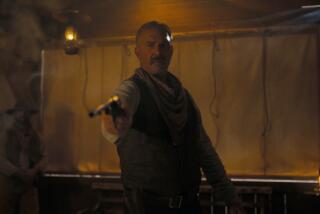MOVIE REVIEW : Costner’s Magic With ‘Wolves’ : In his directorial debut, he creates a frontier epic rich in character, action and spectacle.
Kevin Costner opens his stirringly fine “Dances With Wolves” (selected theaters) by pitching us without prologue or apology into the thick of character and action.
Costner’s Lt. John Dunbar, a wounded Union officer, is next in line to have his foot sawed off at a Tennessee field hospital; preferring to die intact rather than mutilated, he steals back to his men. Nearly hallucinating, he chooses death by galloping between the stalemated Union and Confederate troops, drawing rebel fire and ending his pain.
During his final, full-tilt charge, muttering, “Father, forgive me,” Dunbar drops his reins and throws his arms up and out, looking like a circus rider or a Christ figure, or both. It’s a marvelous moment of cinema, but a dangerously risky one when the star is also the director, and a first-time director at that. It practically invites the professionally cool in the audience to drawl, “Well, who does he think he is?”
Yet played off against Dunbar’s incredulous entry in his journal, “In trying to produce my own death, I became a living hero,” the moment carries exactly the aura of half-mad heroism it’s supposed to. Quite clearly, Costner knows exactly who he is, what he is doing, and how to do it.
He may have studied the way Akira Kurosawa splits his screen with a horizon line or sets a character a little off-center in the vastness of a plain; there are movements of cottonwoods and buffalo grass that may recall “Dersu Uzala,” and figures against a flaming sunset that bring back “Kagemusha,” but there are far worse directors to study if one is starting out.
“Dances With Wolves” is a clear-eyed vision. Authentic as an Edward Curtis photograph, lyrical as a George Catlin oil or a Karl Bodmer landscape, this is a film with a pure ring to it. It’s impossible to call it anything but epic, not with scenes like the ground-shaking buffalo hunt, photographed with the camera moving at the same breakneck speed as the buffalo, while Dunbar and the young Sioux maneuver among them. The work of the buffalo-hunt camera crew is extraordinary, supplementing Dean Semler’s painterly cinematography overall.
Yet somehow, because the film’s screenplay, by Michael Blake, concerns itself with character, not spectacle, its epic quality is engaging, frequently punctuated with gutsy humor, never self-congratulatory. Considering the scope and the ambitiousness of the material, the success of Costner and every one of his team seems monumental. (The film is rated PG-13 for its violence and brief, discreet nudity.)
With his act of suicide seen as reckless bravery, Dunbar, not dead and not footless, is rewarded with any post he wishes. He asks simply for the frontier and is dumped at South Dakota’s Ft. Sedgewick with a wagonload of supplies. The eerily deserted fort is two crumbling sod huts and a broken-down corral on a treeless plain. There’s nothing around for miles, nothing but duty to keep Dunbar there and only his smart horse, Cisco, and a canny wolf for company. And though he doesn’t know it, two deaths have obliterated any official knowledge of his existence out there.
It’s clear from Dunbar’s first night that man and country suit each other. The screenplay may not spell out precisely why, but Costner is good at suggesting a deep, settling-in quality to the reckless Dunbar, jumpy but unafraid out here under an orange Dakota moon.
A poker-faced stickler for regulations, Dunbar assigns himself clean-up duty, carries on dry conversations with Cisco, names and tames his wolf, Two Socks, records his impressions in his journal. And slowly, we come to the essence of this thoughtful, complex man, his character leavened by just enough goofiness to balance his undeniably heroic streak. After seeing these facets in earlier Costner films, solidity without dullness, uninsistent manliness, a measured watchfulness, one might suspect that the Dunbar/Costner fit, as tailored to him by his friend and screenwriter Blake, is pretty close. If so, Costner’s moments undercutting his own image are especially charming.
Then, in a hilarious cross-cultural encounter, the solitary lieutenant is discovered by his Sioux neighbors. Following this confrontation, the filmmakers have made absolute magic; curiousity replaces unease, each side tests the other gravely and is not disillusioned. Dunbar, fascinated, begins to learn something about the character of the Sioux people, tactfully teaching us at the same time.
As the Sioux come alive, a handful stand out: Kicking Bird (Graham Greene), the tribe’s holy man, his hair like a falcon’s top-knot; the hotly combative Wind in His Hair (Rodney A. Grant); tribal leader Ten Bears (singer Floyd Red Crow Westerman), masterly at imposing his knowledge without appearing to, and young Smiles a Lot (Nathan Lee Chasing His Horse), witness to the best and worst in the white strangers. They are a collection of exceptional talents.
In a bow to Western movie tradition, there’s also the luminous-eyed Stands With a Fist (Mary McDonnell), the white-child-raised-by-the-tribe, who moves from mourning widow to reluctant translator to the woman Dunbar loves. Since these people so clearly possess the values and qualities Dunbar has instinctively been drawn to--only heightened and refined--the dawning knowledge of where he truly belongs emerges.
One might remark on the even disposition of every soul in this huge encampment. The natural dangers of their lives aside, these people really have a good day, every day. It’s the Pawnee who are the movie’s “bad Indians.” In the same crabby vein, one might question why there’s no other Army man who shares Dunbar’s humanity, or even curiosity. But as a student of the period remarked, the West wasn’t settled by humanitarians.
Dunbar is given his name Dances With Wolves after a singularly unbuttoned moment, not unlike the one in “Lawrence of Arabia” as Lawrence runs preeningly in his floating white robes, only to find to his mortification that he’s being watched by an Arab stranger. More important is Dunbar’s ecstatic private dance at his own campfire--done with the sort of rapture Lawrence would understand--marking just how far this authentic hero has moved from the stoic Western tradition. It is exactly in the path Kicking Bird has described: the trail of a true human being.
‘DANCES WITH WOLVES’
An Orion Pictures release of a TIG Productions presentation. Producers Jim Wilson, Kevin Costner. Executive producer Jake Eberts. Director Costner. Screenplay Michael Blake, based on his novel “Dances With Wolves.” Music John Barry. Camera Dean Semler. Costumes Elsa Zamparelli. Production design Jeffrey Beecroft. Editor Neil Travis. Art director William Ladd Skinner, set decorator Lisa Dean. Sound Russell Williams, Mary Jo Devenney. With Kevin Costner, Graham Greene, Rodney A. Grant, Mary McDonnell, Floyd Red Crow Westerman, Tantoo Cardinal, Orbert Pastorelli, Maury Chaykin, Jimmy Herman, Nathan Lee Chasing His Horse, Tony Pierce.
Running time: 3 hours, 1 minute.
MPAA-rated: PG-13 (for violence and discreet nudity).
More to Read
Only good movies
Get the Indie Focus newsletter, Mark Olsen's weekly guide to the world of cinema.
You may occasionally receive promotional content from the Los Angeles Times.










